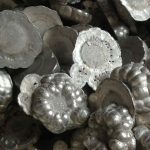Notice: Undefined index: sith_hide_share in /www/sites/alloy.wiki/index/wp-content/themes/likegoogle/single.php on line 32
Deprecated: get_settings is deprecated since version 2.1.0! Use get_option() instead. in /www/sites/alloy.wiki/index/wp-includes/functions.php on line 4862
Titanium and titanium alloys have the advantages of low density, high specific strength and good corrosion resistance, and are widely used in various fields. In order to better apply these materials, researchers have done a lot of research on its forging process.
The main process of titanium alloy forging
Forging is a process of using the plasticity of metal to obtain a plastic forming process with a certain shape and structural properties of the blank under the impact or pressure of the tool. The superiority of forging production is that it can not only obtain the shape of mechanical parts, but also improve the internal structure of the material and improve the mechanical properties of mechanical parts.

1. Free forging
Free forging is generally carried out between two flat dies or molds without a cavity. The tools used in free forging are simple in shape, flexible, short in manufacturing cycle and low in cost. However, labor intensity is high, operation is difficult, productivity is low, the quality of forgings is not high, and the machining allowance is large. Therefore, it is only suitable for use when there are no special requirements for the performance of the parts and the number of parts is small.
2. Open die forging (die forging with burrs)
The blank is deformed between two modules with cavities engraved, the forging is confined inside the cavity, and the excess metal flows out from the narrow gap between the two dies, forming burrs around the forging. Under the resistance of the mold and surrounding burrs, the metal is forced to be pressed into the shape of the mold cavity.
3. Closed die forging (die forging without burrs)
In the closed die forging process, no transverse burrs perpendicular to the direction of die movement are formed. The cavity of the closed forging die has two functions: one is to shape the blank, and the other is to guide.
4. Extrusion die forging
Using extrusion method for die forging, there are two types of forging, forward die forging and reverse die forging. Extrusion die forging can produce various hollow and solid parts, and can obtain forgings with high geometrical precision and denser internal structure.
5. Multi-directional die forging
Performed on a multi-directional die forging machine. In addition to vertical punching and plugging, the multi-directional die forging machine also has two horizontal plungers. Its ejector can also be used for punching. The pressure of the ejector is higher than that of an ordinary hydraulic press. Be big. In multi-directional die forging, the slider acts alternately and jointly on the workpiece from the vertical and horizontal directions, and one or more perforation punches are used to make the metal flow outward from the center of the cavity to fill the cavity. There is no burrs of special forgings on the parting line of barrel parts.
6. Divided forging
In order to forge large integral forgings on the existing hydraulic pressure, segmental die forging methods such as segmented die forging and shim plate die forging can be used. The feature of the partial die forging method is to process the forging piece by piece, processing one part at a time, so the required equipment tonnage can be very small. Generally speaking, this method can be used to process extra-large forgings on medium-sized hydraulic presses.
7. Isothermal die forging
Before forging, the mold is heated to the forging temperature of the blank, and the temperature of the mold and the blank remain the same throughout the forging process, so that a large amount of deformation can be obtained under the action of a small deformation force. Isothermal die forging and isothermal superplastic die forging are very similar, the difference is that before die forging, the blank needs to be superplasticized to make it have equiaxed grains.
Titanium alloy forging process is widely used in aviation and aerospace manufacturing (isothermal die forging process has been used in the production of engine parts and aircraft structural parts), and it is becoming more and more popular in industrial sectors such as automobiles, electric power and ships.
At present, the use cost of titanium materials is relatively high, and many civilian fields have not fully realized the charm of titanium alloys. With the continuous advancement of science, the preparation of titanium and titanium alloy product technology will become simpler and the processing cost will be lower and lower, and the charm of titanium and titanium alloy products will be highlighted in a wider range of fields.
Guest contributors are welcome at the Alloy Wiki.It is a weekly wiki and guide on alloy information and processing technology, while also about the vast array of opportunities that are present in manufacturing. Our team of writers consists of a Machining Material Supplier / Machinist / Tool and Die Maker, a Biomedical Engineer / Product Development Engineer, a Job Development Coordinator / Adjunct Professor, and a President and CEO of a manufacturing facility.
Link to this article:Titanium alloy forging process
Reprint Statement: If there are no special instructions, all articles on this site are original. Please indicate the source for reprinting:Alloy Wiki,thanks!^^


